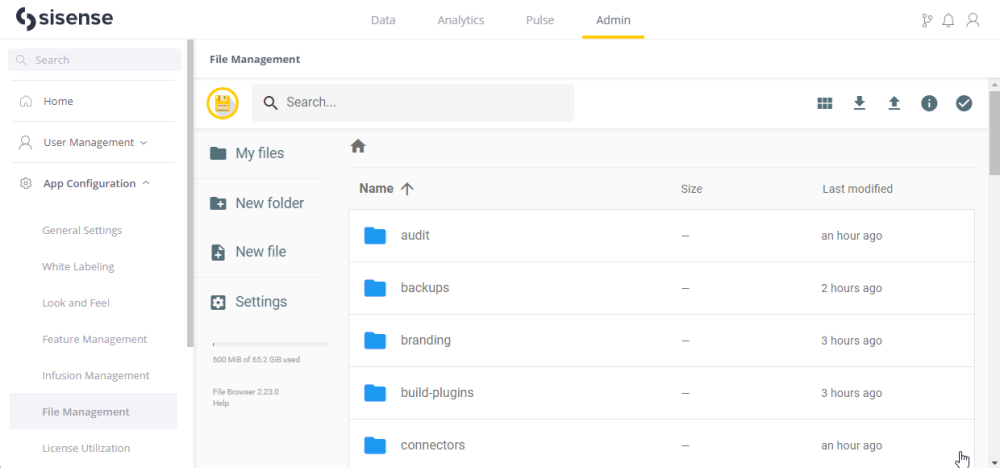Uploading Files to Customize Your Linux Deployment
Tier: Scale
Offering: Cloud, On-Prem
Sisense enables you to upload files to your shared storage so you can customize your deployment with custom connectors, add-ons, translations, and re-branded dashboards.
The system admin (for the main tenant) and tenant admins (for the organization tenants) can manage these files using File Management, (Uploading Files Using File Management). They can also be managed using Kubernetes CLI commands, (Using the Kubernetes CLI).
Enabling File Management
As the system admin, go to the Admin tab, select App Configuration > Feature Management, and in the Management section toggle on File Management. Click Save.
Note:
Only the system admin (for the main tenant) can enable File Management.
Enabling File Management enables it for the system admin and all tenant admins for the organization tenants.
For an explanation of File Management, watch this video:
Uploading Files Using File Management
You can use File Management to upload your static customized files for your Sisense deployment. File Management displays a list of the directories where the relevant customized files can be stored in your shared storage.
The following is a list of the folders where your customized files should be placed:
- branding - The customized files for rebranding Sisense, see White Labeling Sisense.
- emails - The customized automated Sisense emails, see Rebranding Emails .
- plugins - The location for add-ons/plugins.
- samples - The sample ElastiCubes included in your deployment.
- translations - The translations of the Sisense interface.
To access File Management
Navigate to the Admin tab, expand App Configuration, and click File Management.

When the File Management window appears you can upload files by opening the relevant directory and dragging the files into your browser.
File Management Automation
See File Management Automation for File Management if you have your own automation for managing files via API for:
- Authenticating API calls
- Uploading files and folders
- Deleting files and folders
- Renaming files and folders
- Creating new files and folders
- Moving files and folders
Note:
Droppy is an obsolete file browser. It has been replaced with the FileBrowser service.
If you prefer to use the Droppy file sharing platform instead of the default file manager:
-
Use the Kubernetes command line tool to scale down the file browser deployment.
kubectl scale deployment -n sisense filebrowser --replicas=0 -
Scale up the Droppy deployment.
kubectl scale deployment -n sisense droppy-replicas=1 -
In Sisense , navigate to the Admin page and select System Management > Configuration.
-
Click five times on the Sisense logo. The Advanced Configuration page appears.
-
From the menu, select Api-Gateway and navigate to the Filebrowser section.
-
Enter the following value for the filebrowser.proxyUrl field: droppy:8989.

- Click Save Changes.
Note:
For more information about Droppy support for Sisense versions L2021.3 and earlier, see:
Note:
As file management within Sisense is handled by a third-party integrated tool, the steps required via GUI and API interfaces may differ for specific actions. When uploading files using the API, always verify the response codes for each operation involved. For example, uploading a new file via the API may require first creating an empty file (POST request) and then updating it with the content (PATCH request).
Using the Kubernetes CLI
Uploading Files
You can use Kubernetes CLI commands to upload your static customized files for your Sisense deployment.
The following command uploads files to the plugins folder path. You can modify the command to upload files to any other folder in your Sisense shared storage.
- ${SISENSE_NAMESPACE} - Sisense namespace name (default: sisense)
- ${PLUGIN_FOLDER} - Plugins folder path on the server
kubectl cp -n ${SISENSE_NAMESPACE} ${PLUGIN_FOLDER} $(kubectl get pods -n ${SISENSE_NAMESPACE} -l app=management --no-headers -o custom-columns=":metadata.name"):/opt/sisense/storage/plugins/${PLUGIN_FOLDER}
Downloading Files
You can use Kubernetes CLI commands to download files from your Sisense shared storage.
The following commands download files from the plugins folder path. You can modify the commands to download files from any other folder in your Sisense shared storage.
- ${SISENSE_NAMESPACE} - Sisense namespace name (default: sisense)
- ${PLUGIN_FOLDER} - Target folder path for downloading
kubectl cp -n ${SISENSE_NAMESPACE} $(kubectl get pods -n ${SISENSE_NAMESPACE} -l app=management --no-headers -o custom-columns=":metadata.name" ):/opt/sisense/storage/plugins/${PLUGIN_FOLDER}
Example:
kubectl cp -n sisense $(kubectl get pods -n sisense -l app=management --no-headers -o custom-columns=":metadata.name" ):/opt/sisense/storage/plugins/jaqline /jaqline
In this example, sisense.sh is the file specified for downloading.